Deliverable D3.1
Knowledge & Innovation stakeholders in the
ERA_FABRIC regions
MAPPING REGIONAL/LOCAL STAKEHOLDERS AND COMMUNITIES
AND NEEDS ANALYSIS
EXECUTIVE SUMMARY
The main purpose of this document is to show the composition and characteristics of different types of existing and emerging stakeholders in the ERA_FABRIC project partner regions within the 3 thematic domains addressed by the project: Sustainable manufacturing, Bio-based circular economy and Clean renewable energy.
In addition to the mapping of existing stakeholders, an in-depth needs analysis was performed in order to identify current obstacles for the collaboration between different stakeholders within and among the regions. Furthermore, suggestions for improvement of the collaborations and skills needed to support existing ones and establish new ones were also identified.
This mapping document will serve as a pool for the creation of the ERA_FABRIC thematic working groups which, during the project duration, are expected to provide an overview on the forms of regional collaborations on the development of knowledge & innovation, obstacles hindering such cooperation, suggestions for the improvement and what is needed, in a form of institutionalized incentives and policies, to enhance quality of regional knowledge and innovation ecosystems.
ABBREVIATIONS
ERA European Research Area
EU European Union
GDP Gross Domestic Product
GVA Gross Value Added
HE Higher Education
IPR Intellectual Property Rights
K&I Knowledge and Innovation
MS Member States
RDA Regional Development Agency
R&D Research and Development
R&I Research and Innovation
PR Private
P Public
PP Public-Private stakeholders
1. INTRODUCTION
1.1. ERA_FABRIC in a nutshell
The ERA_FABRIC project is to implement a new ERA Hubs concept (COM 2020 628 final) across different geographies and structures in Europe, based on common compliance criteria. The process acts as an incentive for advanced ecosystems to seek recognition, and for less advanced ecosystems to reach the criteria facilitating support from European, national and regional level. Overarching aim of the ERA_FABRIC project is to define, structure, populate and validate the “interconnected knowledge space” foreseen by the EU ERA Hubs initiative.
Three distinct, and intertwined, dimensions, all of them relevant for policy making, are adopted as a structuring principle for the community to be built and cultivated during the project:
- ERA Hubs as Knowledge Ecosystems which foster the dynamic interaction of R&D and innovation actors at regional and multiregional levels, considering the different knowledge and cultural contexts and the alignment of research foci and industrial needs;
- ERA Hubs as Multi Stakeholder Platforms which bring together the representatives of the various involved interest groups in a seamless and uninterrupted discussion and deliberation on strategic priorities, actions and results evaluation;
- ERA Hubs as a Policy Co Creation Toolbox which are a transformative set of measures and tools operating in a “middle ground” needing to be configured as a distinct space from both the EU and the MS (member states) / regional levels, historically presided over by “ad hoc” sets of instruments (e.g. Framework Programmes for R&I, Structural and Investment Funds, Interregional and Cross Border Cooperation Programmes).
It is the consortium’s vision and assumption that the three above dimensions should be presided over and made interoperable, in order for the ERA Hubs initiative to become path breaking and impactful at broad EU level. ERA_FABRIC is designed by leading European actors in the domain of regional development. The 11 partners represent 8 Member States and 1 Associated State. With the addition of the letters of interest gathered before the proposal presentation, almost half of EU27 territorial coverage will be reached.
1.2. The purpose of the mapping
The main objective of the mapping is shedding light on the composition and characteristics of different types of existing and emerging stakeholders from the Quintuple helix, including their communities and networks in the project partner locations. Mapping keeps the distinction among the three thematic domains targeted by the ERA_FABRIC project,
namely: sustainable manufacturing, bio-based circular economy and clean renewable energy.
This mapping document will serve as a pool for the creation of thematic working groups which during the project will provide an overview on the forms of regional collaborations on the development of knowledge & innovation, obstacles hindering such cooperation, suggestions for the improvement and, what is needed, in a form of institutionalized incentives and policies, to enhance quality of regional K&I ecosystem.
Geographic scope of the mapping covers 9 regions included in the project consortium Lower Austria, Jadranska Hrvatska, Jihovzchod, Emilia Romagna, Mazowieckie, Norte, Nord-West Romania, Cataluña and in 8 European countries (Austria, Croatia, Czech Republic, Italy, Norway, Poland, Portugal, Romania and Spain).
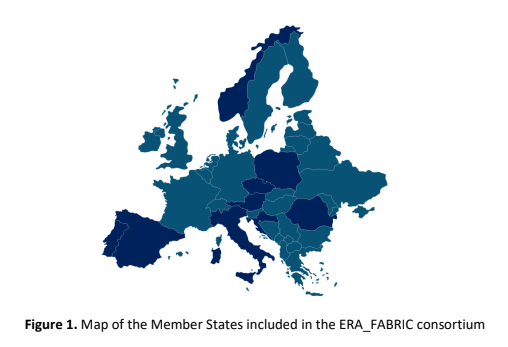
This mapping is supported by an in-depth needs analysis aimed at highlighting the challenges associated with grasping the potential of available knowledge flows and transforming them into opportunities for growth and jobs. Such analysis has been carried out as a result of the first discussions within the aforementioned working groups.
2. METHODOLOGY
The mapping was performed through desk research to identify the main stakeholder groups as well as their role in their respective ecosystem and to gather initial information including contact details and a short description. In case some of the data was not available via the stakeholder website, an additional email or a phone call was made to gather missing information. Publicly available databases and directories, industry associations, research institutions, industry reports and publications, government statistics and reports, social media and online platforms, together with existing partner networks were used as a source of information.
Firstly, the types of stakeholders that are the subject of the mapping were identified and defined in groups and subgroups. Stakeholders that actively contribute to the knowledge and innovation ecosystems, together with those creating policies affecting R&D, implementing R&D activities, or having dedicated departments for R&D were included in the mapping. Selected stakeholders were categorized by their “role in the ecosystem” within one of the following Quintuple helix categories:
- Policy makers: government and public agencies that shape laws, regulations, and policies that affect knowledge and innovation
- Industry representatives: private sector companies, entrepreneurs and investors who develop and commercialize new products and services, creating economic value from knowledge and innovation
- Academia: universities, research institutions and other educational organizations that generate new knowledge and develop the human capital necessary to drive innovation
- Civil Society: community organizations, NGOs and other groups that represent the interests of citizens and promote social and environmental responsibility.
Since classification by the stakeholders’ role in the ecosystem – academy, industry, policy makers, civil society – is very broad and does not provide sufficient clarity on the different types, scope of work and the type of the support that the stakeholder provides in the ecosystem were added as additional classification elements, with the following segmentation:
- Clusters/ professional associations
- Digital Innovation Hubs (regional and those that are part of the EDIH network)
- National/Regional/Local Governments/Municipalities, County councils
- Regional Development Agencies/ Innovation Agencies
- Regional Offices of in-line Ministries responsible for Innovation / Management Authorities or Intermediate Bodies for Innovation related programmes
- Business support infrastructures (logistic parks, industrial parks, technology parks, industry platforms)
- Business Incubators, Hubs, Co-working spaces
- Business Accelerators/ Startup support organizations
- Innovation and Tech transfer organizations, including Science and Technology Parks
- Business angels and venture investment companies
- Sustainable development associations
- Industry representatives having R&D departments or participating in R&D projects
- Higher education institutions
- Research institutes
- Research centers
Based on the baseline desk research, two additional categories were added, taking into consideration the differences between the ERA_FABRIC regions and importance of the above-mentioned stakeholders for the functioning of the regional innovation ecosystems.
Based on the legal status, each stakeholder was grouped into the following categories:
- PR – Private
- P – Public
- PP – Public-Private stakeholders
Considering stakeholders’ level of influence, interest, and potential impact on the ecosystem they were categorized in the three groups (A, B, C) based on the following criteria:
- Influence: The stakeholder’s ability to affect the regional knowledge and innovation ecosystems.
- Interest: The stakeholder’s level of interest in the regional knowledge and innovation ecosystems.
- Potential impact: The stakeholder’s potential impact on the regional knowledge and innovation ecosystems.
- Group A: High priority stakeholders with high influence, interest, and potential impact.
- Group B: Medium priority stakeholders with moderate influence, interest, and potential impact.
- Group C: Low priority stakeholders with low influence, interest, and potential impact.
2.1. Needs analysis methodology
Needs analysis related to the challenges associated with grasping the potential of available knowledge flows and transforming them into opportunities for growth and jobs within the three project domains was the second part of the mapping process. Focus group discussions were implemented in each partner region to gather input for an in-depth needs analysis.
2.1.1. Focus groups’ organization
Each participating region provided an analysis of its respective region elaborated as a result of a focus group activity. The focus groups were set out including all relevant typology of stakeholders, selected from the performed mapping.
The main objective of the focus group was to obtain views and opinions, as clear and honest as possible, from all relevant stakeholder groups. Therefore, two needs were pondered: the creation of an environment where participants felt relaxed and were able to express their opinions at any moment, along with the balance in the participation of all participants, so that no one could get too much of the time in their interventions while others remained silent throughout the session.
Each focus group had one moderator experienced in similar activities and one rapporteur using a collaborative online tool to draft the main outputs and conclusions. The activity started with a self-presentation of the moderator and the presentation of the ERA_FABRIC project and the activity itself. The moderator asked for the participants’ permission to record the meeting for minutes and transcripts purposes. Once the main questions had been answered, the event was closed with a final section where all participants got the opportunity to pose their own questions and suggestions to improve relations and cooperation between all involved in the K&I ecosystems. Furthermore, after the final round of suggestions, the rapporteur shared the Miro board visualizing the discussed topics overall as well as main conclusions.
Focus groups were organized between May 28th and September 14th, 2023. Focus groups were held in the national languages while final conclusions were provided in English. The whole conversation was recorded for reference and future analysis. All participants of the focus groups signed informed consent before participating in the focus groups.
2.1.2. Topics discussed in focus groups
To explore the needs of each region and to be able to compare respective regions and identify similarities, common challenges, opportunities for mutual improvements and possibilities for collaboration, the following questions were discussed:
- How do you collaborate with other organizations in your region on developing regional knowledge and innovation ecosystems? Which challenges have you faced in the process?
- What are the main obstacles your organization faces when developing regional knowledge and innovation partnerships?
- Have you noticed any knowledge or skill gaps within your organization that are obstructing you from taking advantage of existing collaborations and knowledge flows? How might those skills help you to be more integrated in the regional ecosystem?
- Can you pinpoint possible opportunities for growth and job creation which you have noticed through collaborations, projects, or networks related to sustainable manufacturing, bio-based circular economy, and clean renewable energy?
- Do you have any specific policy or incentive in mind which would enhance the transfer of knowledge and expertise between regional stakeholders and the organization? What do you find necessary for the development of an innovation ecosystem?
- What do you see as an indicator of a well-functioning knowledge ecosystem?
2.1.3. Presentation of the results of the needs analysis
Information gathered via focus group discussion was analyzed qualitatively and is presented as narrative conclusions across four main axes of discussion for each of the participating regions:
- OBSTACLES FOR ESTABLISHING KNOWLEDGE & INNOVATION PARTNERSHIPS
- IDEAS FOR IMPROVEMENT
- SKILLS NEEDED TO ENHANCE KNOWLEDGE FLOW
- FORMS OF COLLABORATIONS ON DEVELOPING KNOWLEDGE & INNOVATION
Furthermore, visual conclusions with overlapping issues and ideas across the different regions are presented as a final part of this mapping document.
3. Mapping by the region
3.1. Austria: Lower Austria
3.1.1. Baseline information
Lower Austria as a region surrounds the metropolitan region of Vienna and is dominated by heterogeneity of densely populated bacon-belt / industrial areas vs. sparsely populated rural areas, “shadowed by Vienna” with a high concentration of research education institutions and other relevant stakeholders with higher levels of importance.
In order to build up its own unique selling proposition for research, technology and innovation, Lower Austria has fostered innovation ecosystems such as technopoles, clusters and platforms over the last 20 years. The 4 existing clusters (Green Building, Food, Plastics, Mechatronics) strengthen the innovation capacity of companies, mainly SMEs, all over the region through collaborative innovation activities.
The 4 technopoles connect higher education, research and business on site at 4 technology locations addressing specific technology niches: center for biobased technology in Tulln, center for bioenergy, agricultural and food technology in Wieselburg, center for medical and material technology in Wiener Neustadt and center for health technology in Krems.
3.1.2. Mapping overview
- Total of 25 stakeholders were identified across the Quintuple helix system in Lower Austria
- Out of 25 stakeholders, 10 belong to academia, 8 are industry representatives, while 7 of them are policy makers. No representatives of civil society stakeholders were detected during the mapping process
- The mapping of industry representatives in Lower Austria was focused on bio-based circular economy (7 of them with the exception of 1 stakeholder who belongs to sustainable manufacturing). On the other hand, academia and policy makers are showing a tendency to be spread across all three domains. Majority of academic stakeholders cover bio based circular economy, 11 covers clean renewable energy and 2 of them fits into all three thematic domains. Significant number of policy makers (5 of them) belong to all three domains, while 1 covers bio based circular economy and 1 covers clean renewable energy
- Policy makers are entirely public entities (7 out of 7), while academia stakeholders follow the same pattern (8 public institutions) with the exception of having two institutions which are in joint public-private ownership
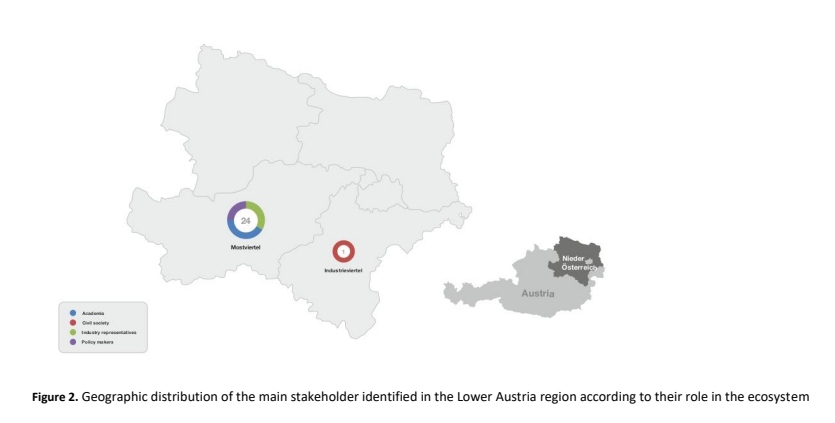
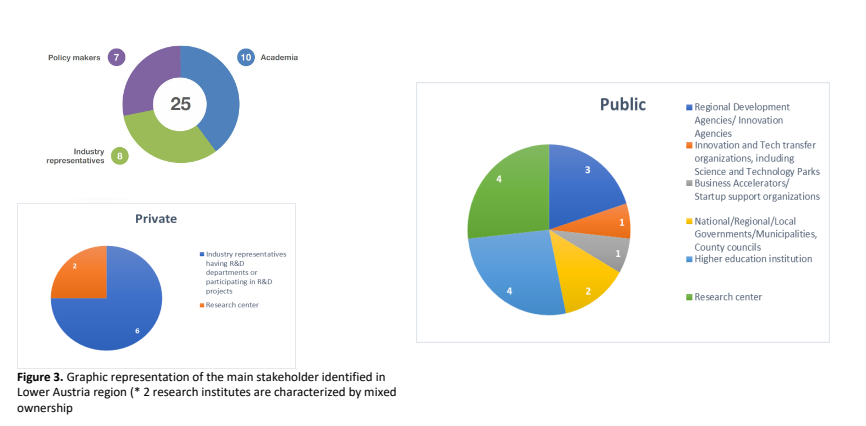
3.2. Croatia: Jadranska Hrvatska
3.2.1. Baseline information
Adriatic Croatia is composed of seven counties as a main type of functional and administrative units within the region. Due to the centralized nature of Croatian governmental framework, regional innovation ecosystems of Adriatic Croatia are strongly embodied into and dependent on the national innovation ecosystem.
At the regional level, research and innovation is coordinated through the network of Counties, Regional Development Agencies, Local Development Agencies and network of Chambers of Commerce for each respective county.
In accordance with the Law on Regional Development, Regional Development Agencies (functioning on the County level) are in charge of creation and implementation of County Development Strategy. On the City level, local authorities are expected to create and implement City Development Plans.
National strategic documents, Smart Specialization Strategy and Innovation Promotion Strategy, and Recovery and Resilience Plan, stipulate tailored incentives and actions for the encouragement of regional development since there are significant differences between Croatian regions, even within the Adriatic Croatia.
3.2.2. Mapping overview
- In total 81 stakeholders ware identified across the Quintuple helix in Jadranska Hrvatska
- Out of 81 stakeholders, 11 belong to academia, 42 are industry representatives, while 28 of them are policy makers. there were no representatives of the civil society identified in the mapping process.
- No significant differences were identified among the thematic domains, as the majority of stakeholders cover all 3 of them. The only category of stakeholders which is segmentized over thematic domains are Industry representatives: while 22 of them cover all of the aforementioned domains, 1 industry representative belongs to bio-based circular economy, 5 of them cover clean renewable energy and 14 stakeholders are based upon sustainable manufacturing
- Industry representatives are the only category which shows tendency to be predominantly private owned, since almost 80% of the subjects are privately owned
- Academia and policy makers are exclusively public entities which are region-specific and nation-wide specific in the case of Jadranska Hrvatska and Croatia itself
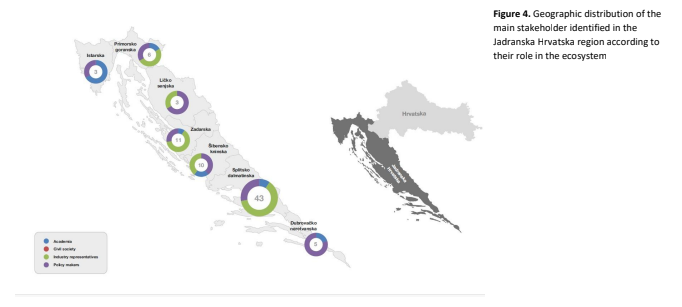

3.3. Czech Republic: South Moravia
3.3.1. Baseline information
The South Moravian Region has an advantageous position on the main transportation arteries toward two capital cities in surrounding states: Bratislava and Vienna. The region has large internal differences in terms of economic performance and situations in local job markets. Its performance is driven by the economic power of Brno (the capital city of the region) and its metropolitan region.
Brno, with its 381,000 inhabitants, represents the nation’s second most important economic and knowledge centre. The region contains six additional regional population centres (Blansko, Břeclav, Hodonín, Vyškov, Znojmo, and Veselí nad Moravou) and five economically and socially disadvantaged territories (Znojmo, Moravský Krumlov, Hodonín, Kyjov, and Veselí nad Moravou).
Brno is home to all universities and nearly all other publicly funded research institutes are located in the region. Also, most companies in general and those investing heavily into research and development are situated in Brno.
South Moravian Region is the most research-intensive region in the Czech Republic with 3.2% share of expenses on R&D out of the region’s GDP, thus also exceeding the capital Prague. In 2019, the population’s level of economic activity remained just slightly below the national average, as did its average wage level. The GDP per capita (PPP based) remained at 96.9% of the national level, and 87.7% of the level for the EU28 (with a year-to-year change of 3.5 percentage points (p.p.). Its 2018 GDP output represented 10.8% of the nation’s output, which nearly corresponded with the region’s share of the population (11.2%). Despite the region’s agricultural and industrial tradition, these sectors lost ground to the rising service sector. In the share of services in the generation of gross value added (GVA – 64.1%), the region placed second among the regions, just behind Prague.
3.3.2. Mapping overview
- Total of 46 stakeholders across the Quintuple helix system in South Moravia were identified.
- Out of 47 stakeholders, 12 belong to the academia, 3 are representatives of the civil society, 27 are industry representatives, while 5 of them are policy makers.
- There is noticeable difference among coverage of thematic domains for two groups of stakeholders: academia and industry representatives. When put in numbers, academic stakeholders are spread as follows: 3 of them cover sustainable manufacturing, 2 represent bio-based circular economy, 1 belongs to clean renewable energy, 1 is a mix between sustainable manufacturing and clean renewable energy, while 5 of them are based upon all three domains. Industry representatives are following a similar pattern: 7 belong to sustainable manufacturing, 2 are built upon bio-based circular economy, 5 are covering clean renewable energy, 4 are mix between sustainable manufacturing and bio-based circular economy, 2 are combining sustainable manufacturing and clean renewable energy, while 7 of them, due to the range of their activities, belong to all three domains.
- Academic, civil society and policy makers are exclusively public entities which is region-specific and nation-wide specific in the case of the South Moravia region and Czech Republic itself.
- Industry representatives is the only category which is almost entirely being privately owned (26 out of 27).
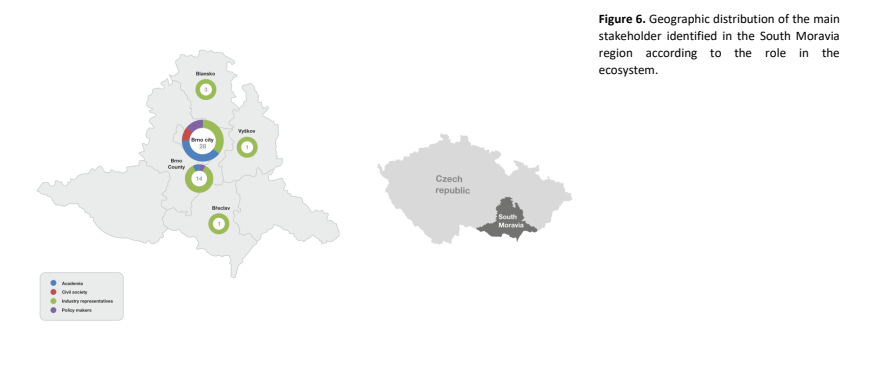
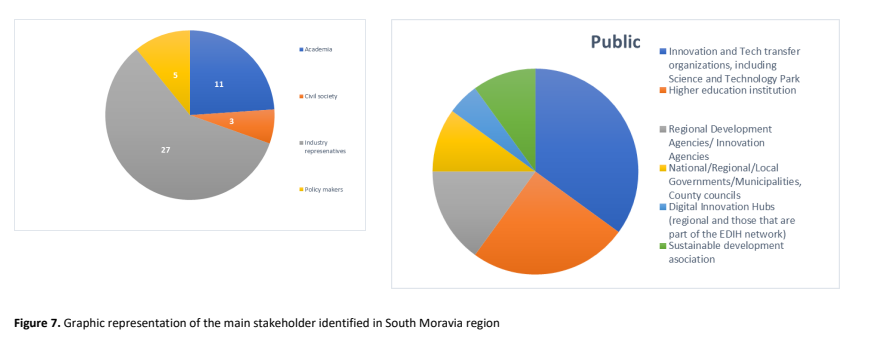
3.4. Italy: Emilia Romagna
3.4.1. Baseline information
At the heart of the Emilia-Romagna innovation ecosystem lies a large number of public and private actors who invest their resources and collaborate in the exploitation of research results, new knowledge development, adoption of new technologies and innovation across all economic and social sectors.
In particular, the role of Emilia-Romagna’s universities and research centres is crucial for development of the production system: knowledge, research and innovation are key factors for economic and production development in this region, where expertise and the diffusion of knowledge ensure competitiveness of the regional economic system in the face of change, with enhancement of regional areas of specialisation on the world market and concurrent consolidation of native production sectors within the territory.
The regional university system is composed of the universities of Bologna, Modena and Reggio Emilia, Ferrara and Parma, with decentralised campuses in the other main cities. In addition, Piacenza is home to the private Catholic University and Milan Polytechnic. Besides academic institutions, the Emilia-Romagna innovation ecosystem is characterized by the several network and cluster organizations gathering together the vast majority of the relevant stakeholders. The most important ones are the Emilia-Romagna High Technology Network, the Technopoles, the Clust-ERs and the recent ECOSISTER network.
The Emilia-Romagna High-Technology Network is composed of 89 Industrial research laboratories and 15 Innovation centres operating in the following fields: agri-food, construction, energy and environment, ICT and design, life science, mechanics and materials. Most of the laboratories are hosted within the Technopoles: 11 infrastructures located throughout the territory that stem from an initiative of the Region in collaboration with ART-ER, universities, research centres and local authorities. They organise activities and services for industrial research, technology transfer and for the development of high skills and careers on innovation.
The Clust-ERs are associations of public and private bodies: companies, research centres and training institutions that share skills, ideas and resources to support the competitiveness of the industrial system in Emilia-Romagna. The Emilia-Romagna Region has found in the Clust-ERs the subjects capable of multiplying innovation opportunities through a collaborative approach, as they focus their activity in R&D strategic sectors: Agrifood, Building and Constructions, Cultural and Creative Industries, Energy and Sustainable Development, Health and Wellbeing, Mechatronics and Motoristics, Service Innovation, Tourism, Urban economy.
Together with the Technopoles and the High Technology Network laboratories, they are one of the key players in the regional innovation ecosystem coordinated by ART-ER, the Emilia Romagna consortium for innovation and technology transfer. In that context, the competitiveness in the region no longer relies on the ability of individual research centres or businesses to operate on the global market, but increasingly on the ability of the entire local system to be innovative and attractive, in order to multiply opportunities and develop strategic projects and partnerships.
In addition to the Clust-ERs and High-Technology Network there is also the Ecosister project including a strong network of 23 public-private partners and 110 million euros of NextGenerationEU funding. Ecosister project integrates with the existing innovation ecosystem in the region (universities, research institutions, laboratories, and innovation centres) to support the productive system of Emilia-Romagna towards a sustainable transition. Ecosister promotes research activities on innovative materials for sustainable ecological transition; clean energy production, storage, and conservation; green manufacturing for a sustainable economy; intelligent solutions for mobility, housing, and carbon-neutral energy; circular economy and blue economy; ecological transition based on high-performance computing and data technology.
ART-ER coordinates Ecosister’s Technology Transfer Innovation Programme (TTIP), which aims to promote industrial research as the main driver for sustainable economic development. The TTIP provides opportunities for all actors in the regional innovation ecosystem – university students and PhD candidates, researchers, innovative startups and research spin-offs, SMEs, companies, civil society organisations, and citizens, as well as the Public Administration – to contribute to the dissemination of green solutions, making the Emilia-Romagna region more sustainable, inclusive, and attractive.
3.4.2. Mapping overview
- Total of 81 relevant stakeholders across the Quintuple helix system were identified in Emilia-Romagna
- Out of 81 stakeholders, 34 belong to academia, 38 are industry representatives, 2 of them are policy makers, while 7 of them belong to civil society
- The highest number of academic stakeholders concentrated around clean renewable energy (14 in total), followed by sustainable manufacturing with 9 representatives, bio-based circular economy (6 stakeholders) and 5 stakeholders who are covering all three thematic domains
- Out of 2 policy makers representatives, 1 covers all three thematic domains, while 1 fit into the clean renewable energy domain. Civil society representatives are equally distributed among clean renewable energy (3 representatives) and those covering all three thematic domains (3 entities), while 1 belongs to bio-based circular economy
- Academia is the only stakeholder which is predominantly in public ownership (27 public entities versus 7 private ones).
- Industry representatives are mainly privately owned (34 private representatives) while 4 of them are characterized by public ownership
- Policy makers are civil society representatives following the same pattern: there are 2 publicly owned policy maker entities and 1 privately owned, while there are 4 public civil society representatives and 2 private entities.
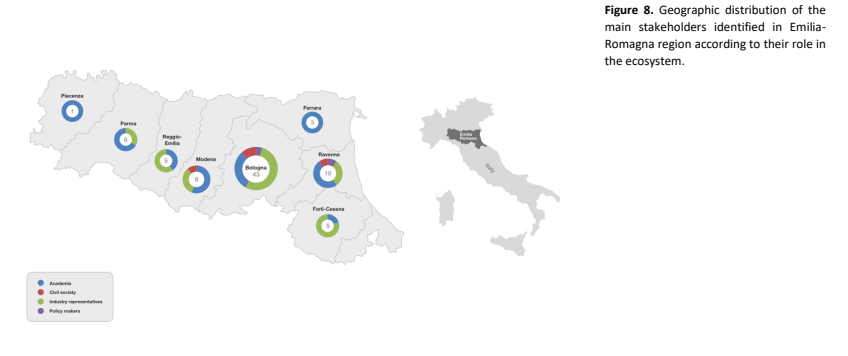
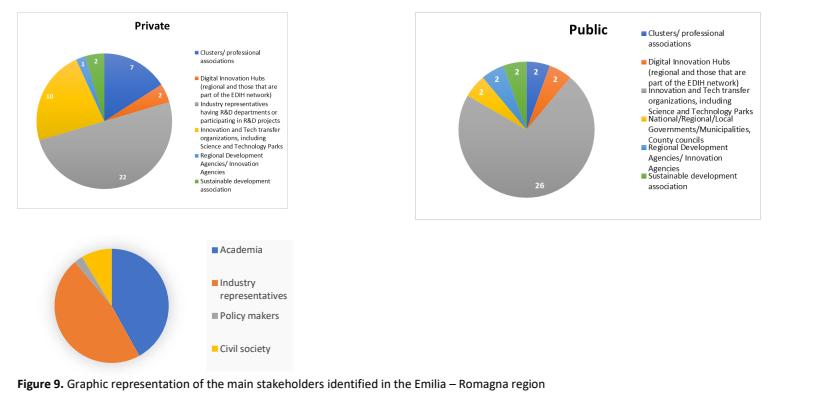
3.5. Norway: Trøndelag
3.5.1. Baseline information
Trøndelag, as a region in Norway, plays a significant role in the Norwegian ecosystem for innovation. Situated in the heart of Norway, Trøndelag is known for its strong industrial heritage, academic excellence, and active participation in research and development. The focus on sustainability and regional development is clearly stated in the county’s regional strategy for Trøndelag (Regional strategy for value creation in Trøndelag 2022-2025) and therefore strongly supports the broader commitment to sustainable growth throughout Norway.
Trøndelag is home to some of Norway’s leading academic and research institutions, including the Norwegian University of Science and Technology (NTNU) and SINTEF, the largest independent research organization in Scandinavia. These actors participate in numerous research and development projects, both on a national and international level. Working closely together with industries all over Norway, these institutes foster cutting
edge research and innovation that provides a valuable foundation for innovation and technology development in fields such as renewable energy, health, and sustainable technologies within the maritime sector.
Trøndelag also has several strong industrial clusters, incubators, and innovation hubs that actively participate in national and international collaborative networks to provide a nurturing environment for start-ups, entrepreneurs, and SMEs. The headquarters of Investinor – a publicly owned VC that manages Norwegian’s state interests in seed capital and pre-seed funding schemes – are also located in Trondheim, rigged to co-invest with private investors to accelerate growth.
Overall, Trøndelag’s active participation in the Norwegian ecosystem for innovation makes it a crucial contributor to the country’s technological advancements and economic growth.
3.5.2. Mapping overview
- Total of 111 stakeholders were identified across the Quintuple helix system in Trøndelag
- Out of 111 stakeholders, 4 belong to academia, 105 are industry representatives, while 2 of them are policy makers. However, there were no civil society stakeholders detected during the mapping process
- No differences in stakeholder distribution were detected when it comes to policy makers as both of them cover all three thematic domains. Academic stakeholders cover mostly clean renewable energy with 50% (2 out of 4) in that sector, while one belongs to sustainable manufacturing and 1 fit into all three thematic domains
- Industry representatives are present across all three thematic domains: 69 of them belong to clean renewable energy, 14 cover bio-based economy, 6 are concentrated in sustainable manufacturing, and 1 fits into all three domains
- Academia and policy makers are entirely publicly owned while, at the same time, industry representatives are entities privately owned (100 out of 105) with the exception of 2 subjects which are publicly owned
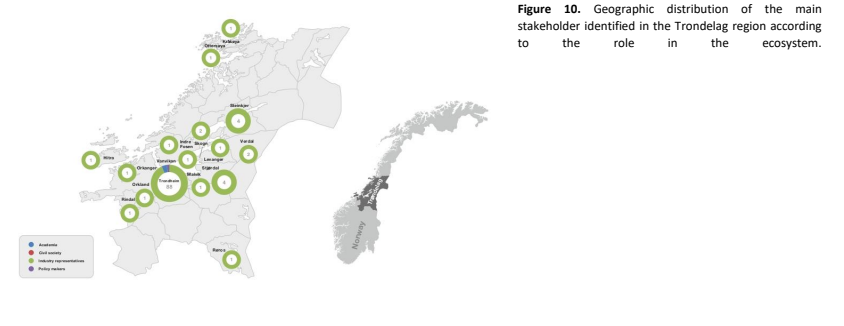

3.6. Poland: Mazowieckie
3.6.1. Baseline information
Mazowieckie Voivodeship includes two NUTS II regions. The Warsaw Capital Region is the leader in almost all innovation rankings in Poland. The Mazovia Regional, opposite to the capital one, usually tends towards the bottom of these rankings. At EU level, according to the European Innovation Scoreboard 2023, Warsaw Capital Region is labeled as Moderate innovator and Mazovia Regional is in the group of Emerging innovators.
Mazovia has a great economic potential. More than 850.000 economic entities operate in the region, but the vast majority of which are concentrated in the Warsaw Capital Region, particularly in the city of Warsaw (more than 70% of the region’s entities). Approx. 1% of all Mazovian companies are hi-tech entities, and 36% are entities of the knowledge-based services sector. Approximately 24% of the total number of companies in Mazovia are active in the field of innovation. Among them, 24.2% of industrial companies and 18% of service companies collaborated with others on innovation activities in 2017-2019. This percentage is strongly differentiated by the size of the company – the larger the company, the greater the propensity to enter into the cooperation on innovation. Such cooperation was undertaken by 33.1% of large industrial enterprises and only 2.1% of small enterprises1.
According to the above report the innovation ecosystem includes: research entities (137), higher education institutions (89), business supporting organisations (60) and clusters (9). Unfortunately, from the perspective of much balanced regional sustainable development, the vast majority of research entities and higher education institutions are based in Warsaw. Development disparities in the area of innovativeness are a natural consequence of the poorer socio-economic situation of municipalities of the Mazovia Regional in comparison to those of the Warsaw Capital Region. This concerns such areas as: the level of local entrepreneurship, unemployment, average gross salary, share of inhabitants with higher education or availability of educational services. As a consequence, there are fewer companies in the Mazovia Regional, including innovative ones. In both regions, the lack of innovation needs is the main reason for not implementing or developing innovations.
The main barriers to the diffusion of innovation in terms of knowledge transfer to the economy are poor supply of knowledge from the science sector to the economy, low effectiveness of intermediaries in the exchange of knowledge between the science sector and the economy, weak demand for knowledge in the economy, poor supply of knowledge suitable for commercialisation, developmental disproportions between the two regions in Mazovia.
Enterprises are more willing to cooperate in carrying out innovative activities with other companies (40% of companies have undertaken such cooperation) than with scientific institutions (20% of companies) and business supporting organisations (9%). For companies undertaking cooperation with the scientific sector, the most frequently selected partners are the Warsaw-based Warsaw universities like Warsaw University of Technology, Warsaw University of Life Sciences, Warsaw University of Technology, and Warsaw University2.
The collaboration between companies and other actors in the innovation ecosystem is established mainly through personal relationships. This is particularly important when establishing cooperation with research institutions – their structure and procedures make it difficult for companies to reach the right person. The initiators of cooperation are primarily companies. Research units rarely reach out to entrepreneurs with their offer. Only 18% of companies cooperating with the sector declare that, in their case, it was an academic unit that proposed cooperation to them. A small percentage of companies use the services of Business Supporting Organisations, which is largely due to unfamiliarity with their offer, or even lack of awareness of their existence.
3.6.2. Mapping overview
- Total of 110 stakeholders across the Quintuple helix system were identified in Mazowieckie region
- Out of 110 stakeholders, 11 belong to the academia, 9 are representatives of the civil society, 74 are industry representatives, while 16 of them are policy makers.
- No significant differences were identified among the thematic domains as the majority of stakeholders cover all 3 of them. The only category of stakeholders which shows tendency to be distributed across different thematic domains are industry representatives: while 54 of them cover all of the aforementioned domains, 3 industry representatives belong to bio-based circular economy, 7 of them cover clean renewable energy and 10 stakeholders are based upon sustainable manufacturing.
- Academic stakeholders are mainly public entities (9 out of 11).
- Industry representatives are the only category which is almost equally distributed between private and public-private types of ownership (39 versus 33), while 2 subjects are publicly owned.

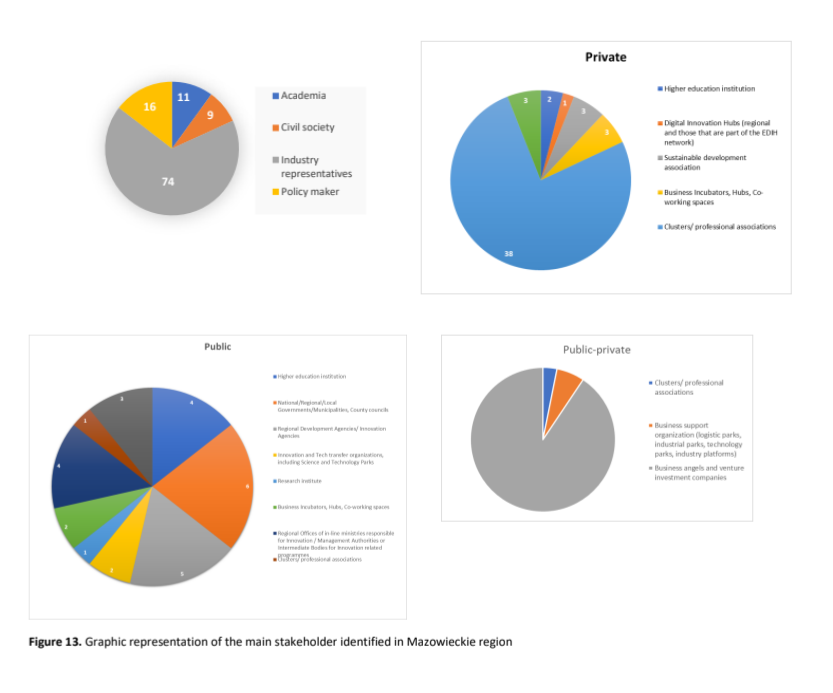
3.7. Portugal: Norte
3.7.1. Baseline information
The best way to analyze Norte region sectoral and thematic alignment of the institutions that make up the regional scientific and technological network is to associate them with the different priority domains of smart specialization of S3 NORTH 2027, namely: (i) Creativity, Fashion and Habitats; (ii) Sustainable Mobility and Energy Transition; (iii) Industrialization and Advanced Manufacturing Systems; (iv) Agro-environmental Systems and Food; (v) Life Sciences and Health; (vi) Territorial Assets and Tourism Services; (vii) Resources and Blue Economy; (viii) Technologies, State, Economy and Society.
Global data allows us to conclude that all priority domains of smart specialization are associated with regional scientific and technological institutions. However, the relative concentration is not indifferent in this analysis, as it can be observed that the highest number of institutions are associated with four domains: Sustainable Mobility and Energy Transition; Industrialization and Advanced Manufacturing Systems; Agro-environmental Systems and Food; Life Sciences and Health. On the other hand, the domain of Territorial Assets and Tourism Services is the one with the least associations, perhaps due to having fewer resources and knowledge and technology-intensive assets.
The regional innovation system (RIS) of the Norte region implies autonomous governance models capable of generating necessary interactions among relevant stakeholders, particularly in entrepreneurial discovery processes. The governance model of RIS establishes, for the first time, the creation of the Regional Innovation Council of the North (CRIN) as an advisory body aimed at ensuring active participation of regional actors in monitoring and continuous evaluation of strategy implementation and contributing to the strategic decision-making process. This advisory body adheres to the quadruple helix model, involving representatives from companies, educational and research institutions, public planning and management entities for R&D&i policies, and innovation users or entities representing the demand and consumers of innovation.
Overall, in the Norte Region there are 57 organisations that can be considered technology infrastructures according to the National Innovation Agency. They range from Technology and Innovation Centres to diverse types of Research and tech transfer units, science and technology parks and S&T incubators.
At the heart of the vision for Europe is the goal of leadership in technology, innovation and economic competitiveness, which is why the development of strategies linked to Research and Innovation has been increasingly evident, favouring the same smart specialisation within territories’ competences and opportunities framework. In Portugal, Innovation and Competitiveness increasingly arise from interactions between economic and non-economicagents, where infrastructures, resources and skills are brought together to develop new solutions in national and international demand.
Technology and Innovation Centres (CTIs) are entities dedicated to the production,
dissemination and transmission of knowledge, aimed at companies and economic value creation, contributing to the pursuit of public policy objectives, within the framework of priority specialization areas, whether national or of the regions in which they operate.
Collaborative Laboratories (CoLabs)
Collaborative Laboratories (CoLABs) are entities dedicated to the production, dissemination and transmission of knowledge by pursuing their own research and innovation agendas. Based on a portfolio of products or systems with higher added value, CoLABs aim to facilitate the access of companies to global markets through exports, as well as to support the attraction of foreign investment in technology-intensive areas. CoLABs can be national, regional/local, or entrepreneurial, steering their activities to the creation of qualified employment and economic and social value in the intermediate space of the innovation system. The Norte region of Portugal hosts 15 CoLabs (for detail, see mapping of entities in the North Region).
3.7.2. Mapping overview
- Total of 57 stakeholders across the Quintuple helix system were identified in Norte region
- Out of 57 stakeholders, 16 belong to academia, 40 are industry representatives, while 1 of them is policy maker. There were no civil society representatives identified in the mapping process.
- Academic stakeholders mostly cover all three thematic domains with the exception of 3 entities which belong to bio-based circular economy and one which covers sustainable manufacturing
- Industry representatives are most notably spread between io-based circular economy (16 stakeholders) and sustainable manufacturing (14 stakeholders). The rest of them either belong to all three thematic domains (16 stakeholders) or to smaller extent to clean renewable energy (3 stakeholders)
- Academia is mostly a public entity (12 out of 16 stakeholders), same as policy makers.
- Industry representatives are into greater extent publicly owned (24 public versus 12 privately owned stakeholders)
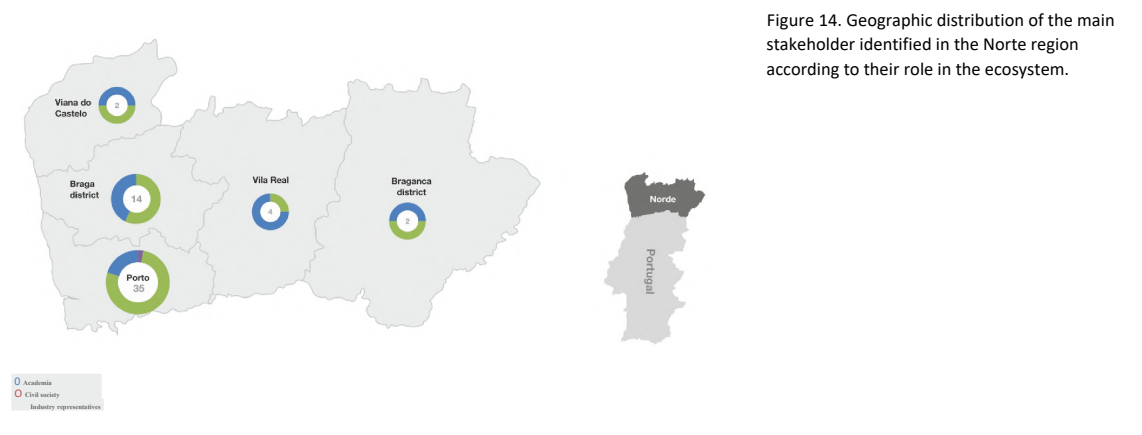
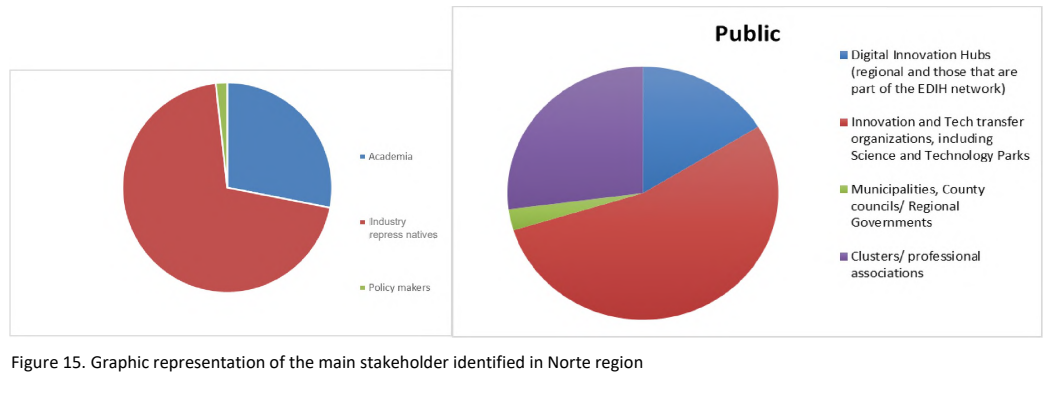
3.8. Romania: Nord – Vest
3.8.1. Baseline information
Romania has 8 development regions at NUTS2 level, which have no legal and
administrative status, but play an important role in the implementation of the Cohesion Policy programmes and regional statistics. They were established in 1998 by the regional development law, currently updated by Law no.315/ 2004.
At the regional level, in Romania there is no regional innovation policy authority.
The support of innovation at regional level is justified by the strategic and programming documents developed at the local and regional level. In each development region is functioning one regional development agency (RDA), which is a non-governmental and nonprofit body of public utility, with legal personality, operating in the field of regional development.
The RDAs are responsible for coordinating the design and implementation of regional development strategies and plans, being the executive bodies of the corresponding Regional Development Councils, composed of appointed elected mayors and county council presidents. In the previous programming period, the RDAs acted as Intermediate Bodies for the ROP 2014-2020 and currently are Managing Authorities for the eight regional-level Regional Programmes in 2021-2027. Within the EU Cohesion Policy, for the first time in Romania, starting from 2021, the Regional Programmes are different for each of the 8 regions and are managed by the regional development agencies as Management Authorities.
From governmental funds, the multi-annual programmes for SMEs development,
competitiveness & innovation capacity, launched by the Ministry of the Economy, are implemented by 8 regional offices of the Agency for SMEs and Export Promotion.
3.8.2. Mapping overview
- Total of 99 stakeholders across the Quintuple helix system were identified in Nord Vest region
- Out of 99 stakeholders, 19 belong to academia, 5 are representatives of the civil society, 61 are industry representatives, while 14 of them are policy makers
- When it comes to policy makers and civil society representatives, no differences were detected among the thematic domains as 100% of those stakeholders cover all 3 of them
- Academia and industry representatives are distributed across all three thematic domains while there are also representatives which cover all three domains. The largest part of academic entities covers all 3 domains (34 of them), while the rest is spread between sustainable manufacturing (5 representatives), bio-based circular economy (4 representatives) and clean renewable energy (2 representatives). Industry representatives predominantly cover all three domains (34 entities) and sustainable manufacturing (22 entities), while a smaller share belongs to bio-based circular economy (2 entities) and clean renewable energy (3 entities)
- Industry representatives are predominantly privately owned (55 out of 61 representatives), while 3 are publicly owned and 3 representatives are characterized by mixed private-public ownership
- Civil society representatives are mainly privately owned (3 entities), while 2 of them are in mixed private-public ownership
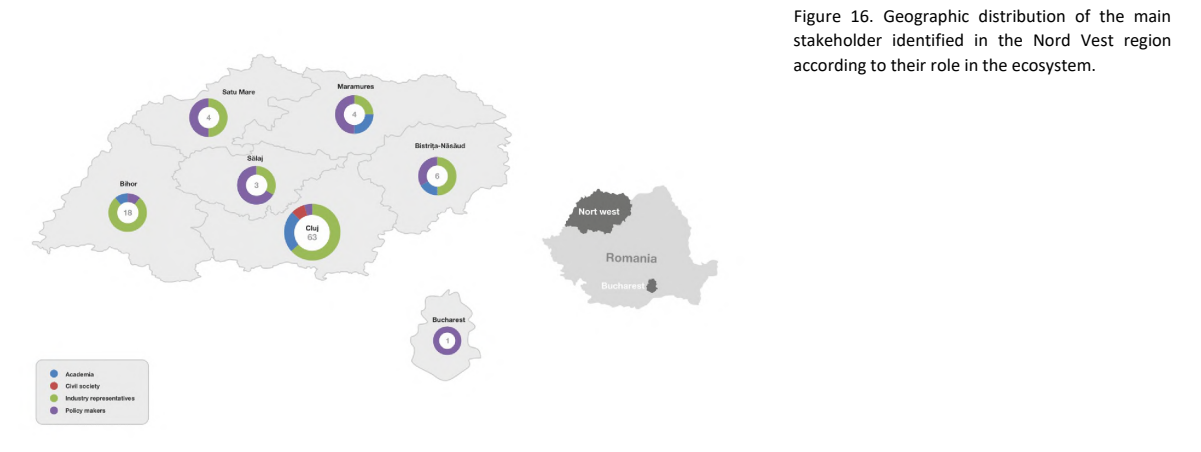
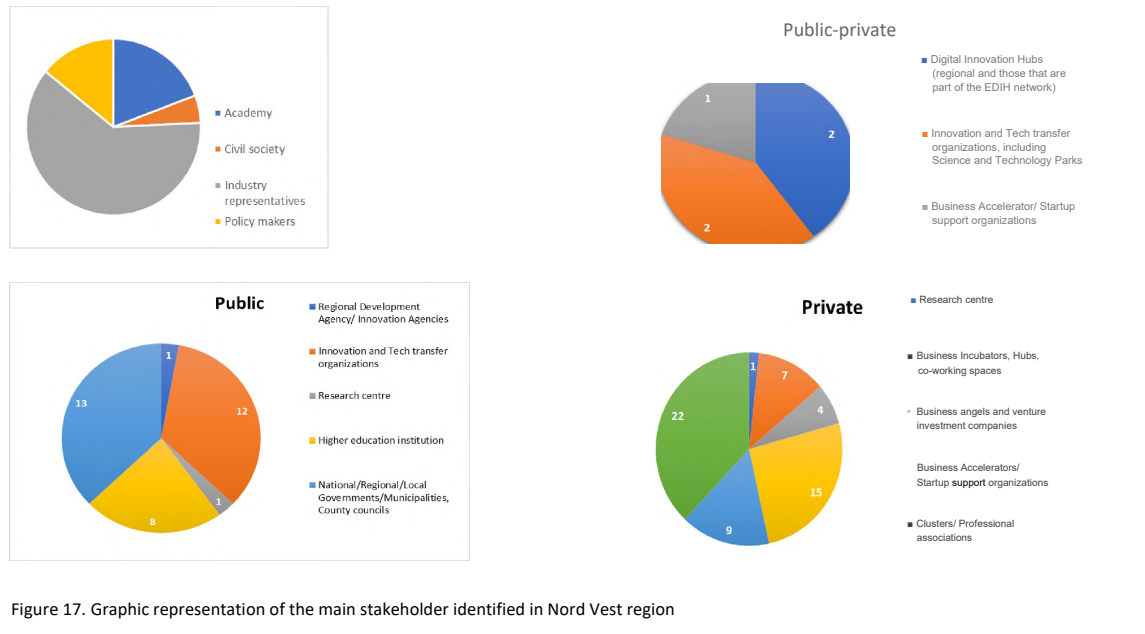
3.9. Spain: Catalonia
3.9.1. Baseline information
Catalonia, as a region in northeastern Spain, boasts a diverse and vibrant knowledge and innovation ecosystem. It is known for its unique blend of industrial strength and cultural heritage, which has contributed to its reputation as a hub for creativity and entrepreneurship. One of the key features of Catalonia’s knowledge and innovation ecosystem is its strong emphasis on research and education. The region is home to several prestigious universities and research institutions, including the University of Barcelona, Pompeu Fabra University, and the Catalonia Institute for Energy Research, among others. These institutions play a crucial role in fostering cutting-edge research and knowledge creation across various disciplines.
Catalonia has also developed a network of innovation clusters and technological parks to
nurture collaboration and innovation among companies. These clusters focus on different sectors and areas of expertise, such as Information and Communication Technologies, Biotechnology, Renewable Energy, and Design. The clusters serve as platforms for knowledge exchange, collaboration, and the development of joint projects, enhancing the innovation capacity of companies operating in Catalonia.
In addition to the clusters, Catalonia has established several technology parks and
innovation centers strategically located throughout the region. These parks serve as physical spaces where academia, research organizations, and businesses can coexist and collaborate. Furthermore, Catalonia has made significant investments in specialized centers that focus on specific technology niches. These centers bring together experts and resources to advance innovation in targeted areas.
Overall, Catalonia’s knowledge and innovation ecosystem benefits from its diverse
industrial base, world-class research institutions, innovation clusters, technological parks, and specialized centers. These elements combine to create a dynamic environment that fosters collaboration, entrepreneurship, and the continuous development of new ideas, positioning Catalonia as a leading region for research, technology, and innovation in Europe.
3.9.2. Mapping overview
- Total of 104 stakeholders across the Quintuple helix system in Catalonia were identified.
- Out of 104 stakeholders, 34 belong to the academia, 1 is representative of the civil society, 52 are industry representatives, while 17 of them are policy makers.
- No differences were detected in stakeholder distribution across thematic domains as the majority of stakeholders cover all 3 of them. There is only 1 policy maker stakeholder belonging to clean renewable energy and 1 civil society stakeholder covering sustainable manufacturing.
- Academy showcases all 3 varieties of the ownership type: private, public and mixed type of the ownership (private-public).
- Policy makers are almost exclusively public entities.
- Industry representatives are mostly private-public entities or private.
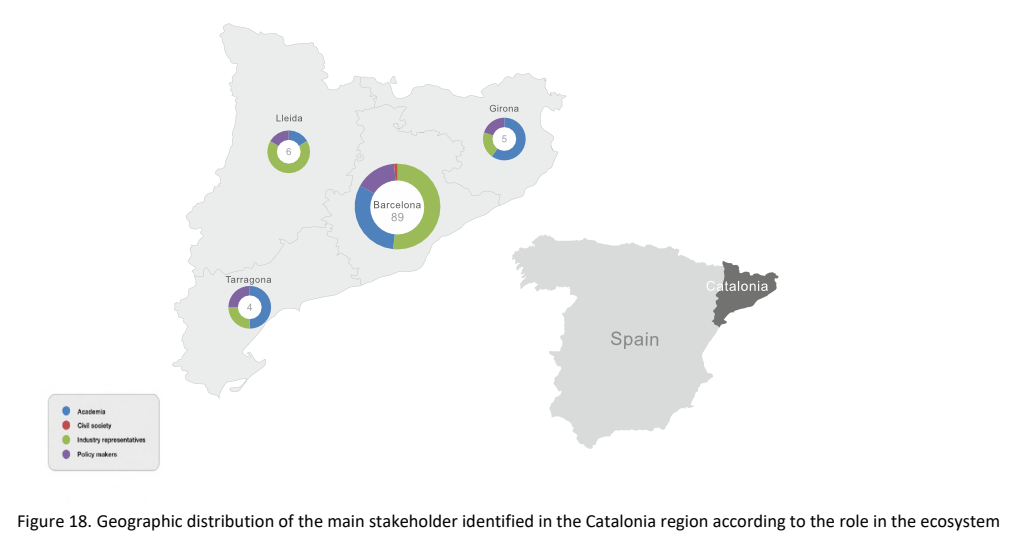

4. Needs analysis results
4.1. Austria: Lower Austria
Focus group was organized on 30th of May. Overall 7 participants confirmed and participated in the event: 3 representatives from university and research organizations and 4 representatives of intermediary organisations including technopole manager, start-up incubator representative and technology transfer agency. The specificity of this focus group was that only two thematic domains were covered: biobased circular economy and clean renewable energy.
Overall, following conclusion was reached for the Ostosterreich region:
- OBSTACLES FOR ESTABLISHING KNOWLEDGE&INNOVATION PARTNERSHIPS
- Lack of time and motivation from researchers for initiating cooperation with companies as they are mainly financed through basic research projects
- Lack of structures and funding instruments for cross-regional cooperation and difficulties in inclusion in pan European or pan regional cooperation (high competition and high administrative burden)
- Knowledge and infrastructure are available in the region but not efficiently used due to duplication and overlaps with no strategic coordination and collaboration of intermediaries in European projects and networks
- There are too many self-contained small networks in the region
- Insufficient market implementation of research results
- Career paths in science and business are separate from each other, researchers hardly found start-ups or switch to a position in private industry (and back to a job in research)
- Not enough funding for prototypes (TRL 6+)
- IDEAS FOR IMPROVEMENT
- Better knowledge about competencies and capacities of potential partners in order to strengthen research capacity as a whole region
- Small basic non-competitive funding to support initiating cooperation and project development
- Better communication of benefits of cooperation in EU
- Incentives to facilitate the job change from science to business (and back)
- Incentives and more time for researchers to pay more attention to the exploitation and usability of research results in research projects (example innovation awards for researchers)
- Instruments to improve accessibility of research results for civil society to increase acceptance and relevance of research together with incentives for “crowd sourcing” of research questions and innovation ideas
- Clear process and standard models how (and at what costs) to transfer IPR from university/research organization to founder in case of a spin-of/start-up
- Bring international investors to Austria
- Specific personnel in research institutions to facilitate spin-offs
- SKILLS NEEDED TO ENHANCE KNOWLEDGE FLOW
- Skills on how to transfer research ideas into businesses
- FORMS OF COLLABORATIONS ON DEVELOPING KNOWLEDGE & INNOVATION
- Improve (increase efforts in) science communication
- Realistic involvement of civil society
4.2. Croatia: Jadranska Hrvatska
Focus group was organized on the 19th of July. Overall 7 participants confirmed and participated in the event while 1 dropped out just before the start of the event: 2 representatives from the management of academic institutions, 2 representatives from the regional policy makers from two different counties, and 2 company representatives (one head of production and one head of the R&D unit).
Overall, following conclusion was reached for the Jadranska Hrvatska region:
- OBSTACLES FOR ESTABLISHING KNOWLEDGE&INNOVATION PARTNERSHIPS
- Sluggishness of the system and lack of the systemic top-down support
- Existing partnerships are established and dependent on the enthusiasm of individuals and their professional connections from prior collaborations
- Small & medium enterprises are not aware of the existing possibilities for cooperation
- No evaluation or incentive mechanism for researchers participating in collaborative projects with companies/industry
- IDEAS FOR IMPROVEMENT
- Creation of established system for attracting investors
- Promotion of best practices and success stories of existing collaborations between different stakeholders
- Organization of conferences and other networking events where representatives of different stakeholders have the opportunity to meet, exchange ideas and initiate collaboration
- Establishment of the industrial PhDs so young researchers are in contact with industry from the very beginning of their carriers
- SKILLS NEEDED TO ENHANCE KNOWLEDGE FLOW
- Transversal skills, such as project management and communication, are recognized as the key ones
- Recognition of research managers as a profession
- Recognized need to educate supporting and administrative staff to provide project support
- Change in mindset and attitudes towards collaboration in the K&I ecosystem
- Joint proof of concept laboratories or testbeds as a place for collaboration between different stakeholders
- FORMS OF COLLABORATIONS ON DEVELOPING KNOWLEDGE & INNOVATION
- Collaborations are predominantly project based and funded from publicly available funds
- Collaborations are based on the individual efforts of usually the same people
4.3. Czech Republic: South Moravia
Focus group was organized on 13th of June. Overall 8 participants confirmed and participated in the event: 1 representative from university and 1 from research organization, 1 representative of the public administration, 1 SME and 4 representatives of intermediary organisations including chambers of commerce, innovation agencies and clusters.
Overall, following conclusion was reached for the South Moravia region:
- OBSTACLES FOR ESTABLISHING KNOWLEDGE & INNOVATION PARTNERSHIPS
- Strategic priorities between universities/companies and city/region are not well aligned – implementing strategic (building) projects takes ages.
- Most activities are centered in the Brno and metropolitan region – this is perceived especially as a challenge by the public administration
- Low structuring of the supporting innovation ecosystem with overlapping roles and no “map” or guidance for companies where to ask for which advice
- Lack of capacity in the SMEs regarding the understanding and inclusion in innovation activities and lack of supporting structures for/within companies
- Universities expect added value from cooperating with companies, while companies have clear needs and sometimes want just an easy service.
- University budgets are tied with project funding – there is very little “free money” to develop own initiative projects with companies
- Mismatch between national and regional policies – good strategies on the regional level, while at the national level strategies are either missing or not being implemented
- There is no funding associated with the Regional Innovation Strategy – individual projects are funded from different funding sources (mainly on the national level)
- Cities and regions primarily support (financially) agencies that they have established and not other supporting actors
- IDEAS FOR IMPROVEMENT
- Measures for greater mobility of people between the academia and business sector
- Improve communication towards the public so that it understands the added value of research and innovation
- Better targeted support for companies
- Networking among companies (start-ups, scale-ups or corporations) and the local research community
- Customized work with corporations on their research needs in a given research area
- Link the Regional Innovation strategy with appropriate funding
- SKILLS NEEDED TO ENHANCE KNOWLEDGE FLOW
- Skills on how to transfer research ideas into businesses employment of relevant people as coordinators of collaboration.
- Innovative public procurement
- FORMS OF COLLABORATIONS ON DEVELOPING KNOWLEDGE & INNOVATION
- Measures for greater mobility of people between the academia and business sector ✔ Transfer of know-how from Brno to the less developed parts of the region. Intermediary instruments
- Funding of long-term systemic operators like South Moravian Innovation Centre or INTEMAC
During the focus group all participants stressed out that the South Moravia region is generally considered the best-performing region in the country in terms of support for innovations and research. With a well-developed innovation ecosystem compared to other regions, including relevant support agencies (for innovations in private/public sector, chamber of commerce, local offices of national support agencies, etc.), good cooperation between the players of regional innovation ecosystem based on mutual trust and small scale of the ecosystem (everyone knows everyone). There is also frequent cooperation between local universities and multinationals based in the region and established support to entrepreneurship, supported by local universities.
4.4.Italy: Emilia Romagna
Focus group was organized on 13th of July. Overall 10 stakeholders confirmed and participated in the event: 3 representatives from regional clusters, 4 representatives of Ecositers hub spokes (coming from Academia), one representative of National research organization, one representative of national municipalities and one representative from the Third Sector Forum.
Overall, following conclusion was reached for the Emilia-Romagna region:
- OBSTACLES FOR ESTABLISHING KNOWLEDGE&INNOVATION PARTNERSHIPS
- Lack of common ground for collaboration due to mismatch in interests or lack of trust
- Organisational and technical difficulties of smaller entities when it comes to the collaboration
- Universities struggling to establish long-term collaboration with companies
- Too many channels of collaboration, simplification is needed
- Difficulties in dissemination of results as there are still industrial actors that are unaware of dedicated university services or do not know whom to approach
- Difficulties in the regulatory field, particularly in the transposition of European directives at the national level
- Remote areas have harder access to the opportunities and resources and are less connected
- IDEAS FOR IMPROVEMENT
- Put in place strategic facilitators of the collaboration (i.e. CLUST-ERs) especially since their network and direct contact is wide
- Incentives for collaboration between industry and academia, especially for the companies lacking own R&D capacities
- Adjusting and reviewing policies to better fit needs of entire ecosystem
- Communicate needs and expectations at an early stage
- Launch of dedicated calls/programs to overcome bottlenecks and fostering a cohesive approach at local level
- Ensure resources to retain the best talents
- SKILLS NEEDED TO ENHANCE KNOWLEDGE FLOW
- Technical skills are necessary, but also facilitation and social innovation skills in the territory for sustainable ecological transition
- Well-trained supporting staff members to boost research and innovation activities
- Improve Communication skills of researchers
- Reinforce the system of competence upskilling and reskilling in order to satisfy the job market demand
- FORMS OF COLLABORATIONS ON DEVELOPIING KNOWLEDGE & INNOVATION
- Good capacity of interaction of the regional ecosystem, highly developed in terms of number of actors and opportunities to develop joint projects
- Public engagement must be taken into account in the development of an ecosystem
4.5. Norway: Trondelag
The focus group was organized on the 22nd of August. Overall 4 participants confirmed and participated in the event: 1 representative from the university, 1 representative from the municipality, and 2 representatives from intermediary organisations and clusters. The specificity of this focus group was that only two thematic domains were covered: biobased circular economy and clean renewable energy.
Overall, the following conclusion was reached for the Trondelag region:
- OBSTACLES FOR ESTABLISHING KNOWLEDGE&INNOVATION PARTNERSHIPS
- Identifying relevant partners and getting in contact with them for projects
- Different expectations put into the project from different stakeholders and lack of common ground for collaboration
- Physical distance between partners is often an issue
- Slow absorption of research results into industry – researcher is moving fast, but the industry needs more time to implement new products
- Number of policy instruments (EU, national government, regional government) with lack of alignment
- IDEAS FOR IMPROVEMENT
- Better knowledge about competencies and capacities of potential partners in order to strengthen research capacity in the region
- Adjusting and reviewing policies to better fit needs of entire ecosystem
- Communicate needs and expectations at an early stage
- SKILLS NEEDED TO ENHANCE KNOWLEDGE FLOW
- Negotiation skills
- Skills on emerging technologies (i.e. using new materials that are being created at a fast pace from other industries)
- FORMS OF COLLABORATIONS ON DEVELOPING KNOWLEDGE & INNOVATION
- Build better networks and understand other regional actor’s needs and competencies
- The Research Council of Norway and Innovation Norway could be more transparent in advance of calls (like the EU does), so that applicants can give feedback
4.6. Poland: Mazowieckie
Focus group was organized on 27th of July. Overall 13 participants confirmed and participated in the event: 5 representatives of academic and research organisations, 3 of public authorities, 3 of chamber of commerce, 2 representatives from the business supporting organisations and one representative of regional agency and professional association.
Overall, following conclusion was reached for the Mazowieckie region:
- OBSTACLES FOR ESTABLISHING KNOWLEDGE&INNOVATION PARTNERSHIPS
- Majority of industry representatives and companies do not see direct benefits from cooperation with regional authorities in local/ regional knowledge and innovation ecosystems
- Complicated (bureaucratic) and quite often limited accessibility in funding schemes and lack of permanent funding holding up collaboration
- A lack of common local/ regional collaborative platforms with available information about the R&I policy processes at local and regional level
- Legal obstacles and lack of flexibility limits involvement in some activities. Public bodies need to follow strict admin procedures to arrange formal activities and have very strict rules on how they can spend/ allocate funds
- Difficulties in approaching right stakeholders, particularly from peripheries of the Mazovia region
- IDEAS FOR IMPROVEMENT
- Improving communication within the ongoing collaborative activities with explaining better purposes, rules and potential benefits
- Identify any motivation from the company representatives that would engage them in collaboration
- Providing incentives to companies for participation in collaborative projects and ensuring clear communication of benefits from participation
- Increasing the awareness of public entities’ procedures runtime duration
- Promotion of the success stories, specifically about the knowledge that transforms the linear model of economy into a network economy with a strong local/ regional dimension
- Employment of knowledgeable and experienced people as coordinators of collaboration
- Competence building and exchange of good practices in collaboration
- SKILLS NEEDED TO ENHANCE KNOWLEDGE FLOW
- Investing in entrepreneurial skills of the young generation
- Leadership
- FORMS OF COLLABORATIONS ON DEVELOPING KNOWLEDGE & INNOVATION
- Instruments supporting soft skills development
- Moderation of collaborative activities matching capital region with peripheries by regional authorities
- Intermediary instruments to support collaboration
4.7. Portugal: Norte
Focus group was organized on 14 of September. Overall 15 participants confirmed and participated in the event: 2 representatives regional clusters and Digital Innovation Hubs, 3 representatives from universities, one representative of National Innovation Agency S3 expert, 2 representatives of Collaborative Laboratories, 4 representatives of CTI – Centers of Technology and Innovation and 2 representatives of industry.
Overall, following conclusion was reached for the Norte region:
- OBSTACLES FOR ESTABLISHING KNOWLEDGE & INNOVATION PARTNERSHIPS
- Limited connection between the scientific and business system and low economic valuation of knowledge (e.g. patents)
- Low qualification of human resources and reduced investment in business R&D and innovation and salaries that are not competitive enough to attract and retain qualified human resources
- Imbalanced network of SRI institutions, with a clear division between low-density territories and the rest of the region
- Low technology intensity which results in low economic output
- Overwhelming majority of micro and small and medium-size companies (but with a tendency for clear growth in high-tech startups, spin-offs and tech upgrade in SMEs and large companies);
- Mismatch between academic and industrial timescales and methodologies
- IDEAS FOR IMPROVEMENT
- Formalize and consolidate the Regional Innovation System (RIS) which would be capable of responding to the challenges of valorizing products and activities in the Norte region
- Align innovation support with the regional strategy, based on the governance model of the smart specialization regional strategy and a better coordination with the European Structural and Investment Funds.
- Promote and attract selective investment to enhance high value-added economic activities, with environmentally friendly technologies and products
- Increase public funding designed to support the integration of PhD researchers in industrial settings, joint projects that are high TRL oriented and focused on developing technology solutions, higher co-fund percentages for both R&I institutions
- Reinforce cluster-based approaches to collaboration and networking
- SKILLS NEEDED TO ENHANCE KNOWLEDGE FLOW
- Continue developing distinctive knowledge in various fields of smart specialization aimed at enhancing economic and social activities, the provision of goods and services, and tangible and intangible heritage.
- Well trained Intellectual property specialists, business development specialists and communication specialists – cutting across the disciplinary boundaries
- Risk mindset and capacity to absorb and integrate innovative processes and technology
- Management skills
- Retain and attract individuals and enhance their multiple and irreplaceable talents, from creatives to entrepreneurs, in a context of continuous improvement of their educational and skill levels.
4.8. Romania: Nord Vest
Focus group was organized on 29h of June. Overall 41 participants (and 29 entities) confirmed and participated in the event: 4 representatives of public administration/municipalities, 3 representatives from regional development agency, 6 participants from universities and technology transfer offices, 9 from clusters, 6 from civil society, 6 from accelerators and incubators and 1 from financial institution and 6 from companies.
Overall, following conclusion was reached for the Nord Vest region:
- OBSTACLES FOR ESTABLISHING KNOWLEDGE&INNOVATION PARTNERSHIPS
- Number of EU and nationally funded projects but no strategic approach and mutual collaboration between important stakeholders in the region
- Strong disparity between Cluj city and the rest of the 42 cities in the region, in terms innovation related activities and results Lack of private money (own money) of clusters and accelerators
- Strong disparity between urban and rural in terms of activities (both innovation and economic related)
- Companies difficult to engage in innovation related actions
- Except clusters (which represent a very small part of the companies in the region), there are no active business association to commit and also no business support authorities to engage them (chambers of commerce in Romania are NGOs , are not public entities and the membership is not mandatory – few companies are members of chambers
- Competition among the regional stakeholders and focus on individual growth rather than on collaborative instruments
- Lack of trans-sectoral support
- IDEAS FOR IMPROVEMENT
- Increase public support to startups
- A better synergy between planning projects & initiative among the regional stakeholders
- Better visibility of each others expertise together with the platform for promoting research outcomes and innovative demand
- Matchmaking sectors by connecting supply and demand of technology and innovative services and products
- Develop a network of HE project writing – by training staff in RTOs, companies and consultants
- Need for a common committed strategy for growth, in terms of innovation, to ensure complementarity of actions and intra-regional synergies
- SKILLS NEEDED TO ENHANCE KNOWLEDGE FLOW
- Expertise for access to funding – only few organisations/ small teams have the capacity to write European projects (based in clusters, universities, regional development agency)
- Actions for capacity building and staff exchanged between organisations
- Lack of expertise in companies for project writing / consultancy companies not experiences in supporting HE project writing, merely focus on nationals ERDF calls
- FORMS OF COLLABORATIONS ON DEVELOPING KNOWLEDGE & INNOVATION
- Organization of working groups based on common interest fields, to constantly explore interests and opportunities
- Organization of info days for access to funding
- Organization of working session for project writing
4.9. Spain: Catalonia
Focus group was organized on 29th of June. Overall 8 participants confirmed and participated in the event: 2 representatives from university, 2 representatives from public administration, 1 representative of intermediary organization, one from clusters and one from SMEs and one from communication.
Overall, following conclusion was reached for the Catalonia region:
- OBSTACLES FOR ESTABLISHING KNOWLEDGE&INNOVATION PARTNERSHIPS
- The mismatch in project expectations from research institutions and private sector
- Participation in tenders and lack of trust when it comes to the selection process and its transparency
- Lack of communication and knowledge of the positive impact that cross-sectoral collaborations may have in society
- Complex and time consuming bureaucratic process that hinders some actors from participation
- There is a lack of entrepreneurship and culture of “fear”, and a lack of courage, about entrepreneurship.
- Certain companies (especially SMEs) do not have the necessary knowledge to have a meaningful participation in big tenders, especially European/international
- The main problem in research is talent retention. It is almost impossible to compete with the private sector when there is such a big difference in salaries and in contract quality.
- Misalignment of expectations between clients and technology providers due to the TRL system regarding the framework of a service provision
- IPR conflicts in the process of transfer of knowledge, mainly when the co creation takes places in a project
- IDEAS FOR IMPROVEMENT
- More resources and incentives to retain talent in universities and research centers in order to be able to compete with the private sector
- Creation of additional indicators in order to measure the innovation progress and degree in the region (i.e. creation of spin-offs, number of patents, rather than purely academic stuff such as scientific publications)
- Recognition of the orchestration role of regional administrations and acknowledgment of their profession and salaries in line with the responsibilities and amount of job.
- Emphasize the importance of co creation processes in the development and transfer of knowledge
- Improve the communication among agents to align project expectations
- SKILLS NEEDED TO ENHANCE KNOWLEDGE FLOW
- Lack of competences of the people in organizations for an ecosystemic and holistic approach of the challenges to be tackled
- Improve knowledge of European tendering processes among SMEs
- FORMS OF COLLABORATIONS ON DEVELOPING KNOWLEDGE & INNOVATION
- Facilitate good practices, real examples and clarifications on general terms related to TRL system and IPR management in an easier and understandable way
As a positive side it was emphasized positive feedback when it comes to the procedures related to the management of IP and ecosystem provides tools and processes to manage it properly.
4.10. Needs analysis conclusions
Focus group discussions and needs analysis showed that, although there are many differences in terms of state of the development of regional knowledge and innovation ecosystems of the ERA FABRIC regions, specifically in terms of number and type of stakeholders and their role in the ecosystems, as well as types of collaborations that are existing, we all share some common problems and obstacles when it comes to the collaboration.
The graph at Figure 20 presents common obstacles, ideas for improvement and types of the knowledge flows and collaboration foreseen that are common for all ERA_FABRIC regions.
This map sets baseline info that will help ERA_FABRIC consortium in creating and developing the next working groups activities and elaboration of policy recommendations but also to create ideas for the future events and activities that will serve as an example of change of knowledge and innovation ecosystem, creating better collaboration pathways and impact for society.
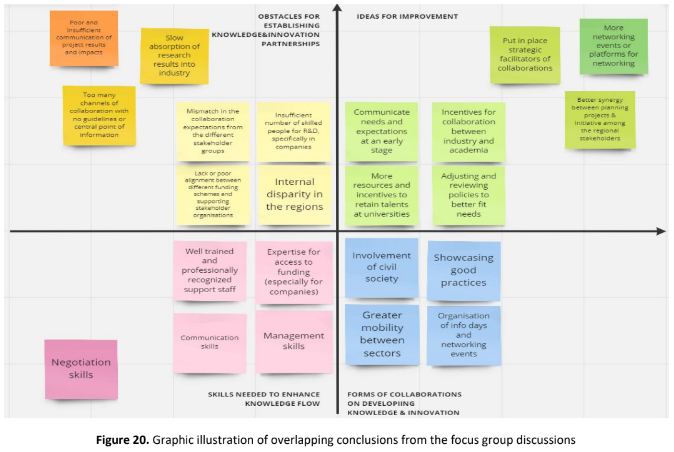
7. RISK MANAGEMENT
7.1 General principles
Risk management in the ERA_FABRIC project has the overall objective of assuring: ∙ timely execution of project tasks, milestone achievements and reporting delivery,
∙ avoidance of defaulting situations by early identification of risks and proposal for their mitigation;
having in mind that timely awareness and consequent reactions to potential problems are crucial for a smooth project implementation.
The approach to risk management consists of the following five steps:
- risk identification, the main goal of this step is to uncover risks before they actually arise;
- risk assessment, risks identified in the previous step are assessed taking into account the probability of occurrence and the level of severity;
- potential risk treatments, for each identified and assessed risk, possible risk treatments are proposed;
- detailed risk management plan, risk management plan consists of a description of risks, assessment and treatment procedures, risk indicators, appropriate mitigation measures and respective responsible persons;
- risk reviewing and continuous evaluation, risk management plan is reviewed along the entire course of the project.
Is assumed that Project management will include a continuous monitoring of risks (of both internal and external origin) focusing on all factors that are critical to the success of the project. The risk management plan starts form the preliminary analysis carried out during the project proposal elaboration and included in Part A at the “ List of Critical risks” paragraph.
7.2 Risk identification procedures
Risks should be reported by any partner as soon as detected: the earliest a risk is detected the easiest will be minimizing its impact.
Partners are invited to submit risks anytime using the Risks Identification Table that will be available in the internal collaboration platform containing the following information fields:
- Nature: this field indicates which type of category the risk belongs to. One or more of the following categories must be selected:
- Formalisation: risks related to a bad definition of requirements, bad interpretation of data and / or a lack of inclusion of experts and reference entities;
- External: risks related to external inputs, data, technologies, introduction of new laws of European or national scope, governance framework. Legal issues will be classified under this category;
- Organizational: risks related to general workflow of the project;
- Technical: risks related to technical aspects of the project such as expected inputs for a certain work package needed earlier than defined in the project schedule.
- Description of the risk: this field is used to establish the border conditions of the risk. Partner has to explain in detail: the risk origin, the trigger for the risk to become a reality and the risk that the Project is facing;
- Affected WPs: WPs affected by the possibility of the risk to happen; ∙ Observation period: estimation of the time span in which the risk may arise;
- Likelihood: a quantitative evaluation of the probability of the risk to concretize during the Project;
- Severity / Impact: a quantitative evaluation of the effect of the risk on the Project should it happen;
- Risk factor: a comprehensive quantification, both in terms of likelihood and impact, of the importance of the risk for the Project management;
- Proposed mitigation action: this field is used to define the proposal of actions to be undertaken in order to mitigate the probability of occurrence of the risk and its eventual impact.
- Nature: this field indicates which type of category the risk belongs to. One or more of the following categories must be selected:
The Risk report must be submitted to Coordinator and Affected WPLs.
7.3 Risk analysis procedures
After the submission of the risk, Affected WPLs (involving TL if considered relevant) are asked to place comments on the risk submitted, especially about the quantification of the likelihood and impact. The quantification of project risks is performed considering the most likely outcome scenario for all identified risks. This procedure encompasses the definition of values for:
- Likelihood measurement: this measurement describes the perception of the probability that the selected risk affects the project in an estimated amount of time (observation period). This information will be used by the relevant WPL and the Project Coordinator for prioritizing the actions that will help to mitigate the risk. Possible values of this field are:
- 5. CERTAIN: is affecting / will affect the project;
- 4. PROBABLE: not certain, but is likely to affect the project.
- 3. POSSIBLE: could affect the project
- 2. UNLIKELY: will probably not affect the project
- 1. VERY UNLIKELY: virtually certain not to affect the project.
- Likelihood measurement: this measurement describes the perception of the probability that the selected risk affects the project in an estimated amount of time (observation period). This information will be used by the relevant WPL and the Project Coordinator for prioritizing the actions that will help to mitigate the risk. Possible values of this field are:
- Severity/Impact Measurement: this measurement describes the perception of the impact if the risk were realised. Possible values of this field are:
- 5. EXTREME Catastrophic effect – the majority of targets will not be met across the project;
- 4. MAJOR relevant effect on project performance –-critical targets will be missed;
- 3. MODERATE Moderate effect on project performance – local performance targets will be missed;
- 2. MINOR Minor effect on project performance – limited effect on targets;
- 1. NEGLIGIBLE Insignificant effect.<
- Risk factor: the result of multiplying Likelihood and Severity gives as result a number from 0 to 25 (Risk factor) that enables to prioritize the risk importance.
7.4 Risk management procedures
This part of the process of risk management is aimed at defining and put in place a risk management plan containing appropriate measures to avoid, mitigate or accept the risks.
Three possible policies can be applied in order to deal with risks:
- Avoid the risk: some risks may be avoided with an adjustment to the project schedule or approach;
- Mitigate the risk: the majority of risks will need a mitigation action to manage them and try to minimize their impact in the project development. If this strategy is chosen, then it is necessary to define and describe the mitigation action for managing that risk. That implies making considerations and detailing when those actions will be executed and by which partner(s).
- Accept the risk: a very small number of risks will be accepted. The acceptance of a risk means that all the actions that can be applied to minimize the impact are more expensive in time and resources that accepting the consequences of that risk.
The risk mitigation strategy with specific tasks must be managed as any other project task. This includes securing the resources, assignment to individual project team members, motivating the involved project team members, overseeing and controlling the execution of the tasks and finally measuring and reporting the progress of risk mitigation. A mitigation plan foresees the description of:
- actions;
- time schedule of that actions;
- responsible partners for those actions, ie identify a leader to manage the risk.
The final definition of the risk management plan will be made by the risk management board, that is defined, according to the relevance of the Risk Factor as follows:
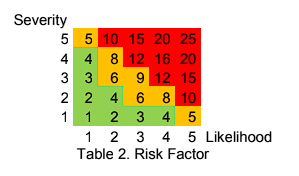
If Risk factor is lower than 5: Coordinator and Affected WPL
For Risk factor between 5 and 9: WPLs Board
For Risk factor between 10 and 25: Steering Committee
The risk log is handled by Task 1.3 Leader: UNIST.
Annex 1: Checklist for deliverables
1. Overall technical evaluation of the deliverable
Does the deliverable contain new, or value added information? : € Yes € No
Are there any major technical errors, omissions, lack of necessary details? : € Yes € No
How do the results compare with the state of the art and/or parallel activities? € Well € Poor
What value does the document add to the project partners? € High € Low
2. Executive summary. Are the following questions clearly asked and answered?:
Which problem(s) and key questions of interest to intended readers are addressed? : € Yes € No
What are the expected main benefits of this deliverable? : € Yes € No
What are the results contained in this deliverable? : € Yes € No
Who are the main consumers for this deliverable, e.g. who should read it? : € Yes € No
Why should I read the deliverable? : € Yes € No
3. Introduction
Is the purpose of the document clearly stated : € Yes € No
Is the technical subject properly introduced? : € Yes € No
If necessary, is there a guide to the reader (document structure, short description of chapters and
relationships)? : € Yes € No
If necessary, are there statements on technical assumption, readers’ prerequisites, relationships with other documents or parallel activities: € Yes € No

